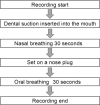Dental Suction Interference and Acoustic Respiratory Monitoring
- PMID: 39711455
- PMCID: PMC11614464
- DOI: 10.2344/23-00017
Dental Suction Interference and Acoustic Respiratory Monitoring
Abstract
Objective: Previous studies have reported that the noise generated by dental equipment can interfere with the auscultation of respiratory sounds during sedation. Therefore, this study aimed to identify whether positing the acoustic sensor on the chest or cervical position would be least susceptible to interference from dental suction device noise, a prominent noise noted during respiratory sound monitoring during dental sedation.
Methods: This prospective cohort study was conducted with 30 students. Sound intensity (dB) and frequency (kHz) levels from the dental suction were recorded from the cervical and chest regions under both oral and nasal breathing conditions and analyzed.
Results: The mean intensity of dental suction sounds was significantly lower in the chest region compared with the cervical region, regardless of the breathing condition (P < .001). Furthermore, in the chest region, the mean sound frequency during oral breathing was significantly lower than that during nasal breathing (P < .01).
Conclusions: Our study suggests that monitoring respiratory sounds in the chest region can significantly reduce interference from noise generated by dental suction devices compared with monitoring at the cervical region.
Keywords: Deep sedation; Dental treatment; Respiratory monitoring; Sedation; Sound monitoring.
Figures



References
-
- Practice guidelines for moderate procedural sedation and analgesia 2018: a report by the American Society of Anesthesiologists Task Force on Moderate Procedural Sedation and Analgesia, the American Association of Oral and Maxillofacial Surgeons, American College of Radiology, American Dental Association, American Society of Dentist Anesthesiologists, and Society of Interventional Radiology. Anesthesiology. 2018;128:437–479. - PubMed
-
- Dobson G, Chong MA, Chow L, et al. Procedural sedation: a position paper of the Canadian Anesthesiologists’ Society. Can J Anaesth. 2018;65:1372–1384. - PubMed
-
- Hinkelbein J, Lamperti M, Akeson J, et al. European Society of Anesthesiology and European Board of Anesthesiology guidelines for procedural sedation and analgesia in adults. Eur J Anaesthesiol. 2018;35:6–24. - PubMed
-
- Keidan I, Gravenstein D, Berkenstadt H, Ziv A, Shavit I, Sidi A Supplemental oxygen compromises the use of pulse oximetry for detection of apnea and hypoventilation during sedation in simulated pediatric patients. Pediatrics. 2008;122:293–298. - PubMed
MeSH terms
LinkOut - more resources
Full Text Sources
Miscellaneous

